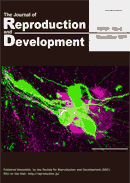Volume 57, Issue 5
October
Displaying 1-15 of 15 articles from this issue
- |<
- <
- 1
- >
- >|
Review
-
Article type: -Review-
2011 Volume 57 Issue 5 Pages 557-563
Published: 2011
Released on J-STAGE: November 04, 2011
Download PDF (2084K)
Original Article
-
Article type: -Original Article-
2011 Volume 57 Issue 5 Pages 564-571
Published: 2011
Released on J-STAGE: November 04, 2011
Advance online publication: June 03, 2011Download PDF (2729K) -
Article type: -Original Article-
2011 Volume 57 Issue 5 Pages 572-578
Published: 2011
Released on J-STAGE: November 04, 2011
Advance online publication: June 10, 2011Download PDF (232K) -
Article type: -Original Article-
2011 Volume 57 Issue 5 Pages 579-585
Published: 2011
Released on J-STAGE: November 04, 2011
Advance online publication: June 10, 2011Download PDF (1014K) -
Article type: -Original Article-
2011 Volume 57 Issue 5 Pages 586-593
Published: 2011
Released on J-STAGE: November 04, 2011
Advance online publication: June 03, 2011Download PDF (1422K) -
Article type: -Original Article-
2011 Volume 57 Issue 5 Pages 594-603
Published: 2011
Released on J-STAGE: November 04, 2011
Advance online publication: June 17, 2011Download PDF (4800K) -
Article type: -Original Article-
2011 Volume 57 Issue 5 Pages 604-612
Published: 2011
Released on J-STAGE: November 04, 2011
Advance online publication: June 17, 2011Download PDF (1807K) -
Article type: -Original Article-
2011 Volume 57 Issue 5 Pages 613-619
Published: 2011
Released on J-STAGE: November 04, 2011
Advance online publication: June 17, 2011Download PDF (461K) -
Article type: -Original Article-
2011 Volume 57 Issue 5 Pages 620-626
Published: 2011
Released on J-STAGE: November 04, 2011
Advance online publication: June 17, 2011Download PDF (440K) -
Article type: -Original Article-
2011 Volume 57 Issue 5 Pages 627-635
Published: 2011
Released on J-STAGE: November 04, 2011
Advance online publication: July 11, 2011Download PDF (1618K) -
Article type: -Original Article-
2011 Volume 57 Issue 5 Pages 636-642
Published: 2011
Released on J-STAGE: November 04, 2011
Advance online publication: August 05, 2011Download PDF (2861K) -
Article type: -Original Article-
2011 Volume 57 Issue 5 Pages 643-649
Published: 2011
Released on J-STAGE: November 04, 2011
Advance online publication: July 16, 2011Download PDF (426K)
Technology Report
-
Article type: -Technology Report-
2011 Volume 57 Issue 5 Pages 650-654
Published: 2011
Released on J-STAGE: November 04, 2011
Advance online publication: July 01, 2011Download PDF (1109K) -
Article type: -Technology Report-
2011 Volume 57 Issue 5 Pages 655-659
Published: 2011
Released on J-STAGE: November 04, 2011
Advance online publication: July 16, 2011Download PDF (436K) -
Article type: -Technology Report-
2011 Volume 57 Issue 5 Pages 660-664
Published: 2011
Released on J-STAGE: November 04, 2011
Advance online publication: July 30, 2011Download PDF (488K)
- |<
- <
- 1
- >
- >|
